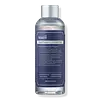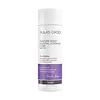What's inside
What's inside
 Key Ingredients
Key Ingredients

 Benefits
Benefits

 Concerns
Concerns

No concerns
 Ingredients Side-by-side
Ingredients Side-by-side

Water
Skin ConditioningButylene Glycol
HumectantDimethyl Sulfone
SolventBetaine
HumectantCaprylic/Capric Triglyceride
MaskingNatto Gum
Sodium Hyaluronate
HumectantDisodium EDTA
Centella Asiatica Extract
CleansingGlycyrrhiza Glabra Root Extract
BleachingPolyquaternium-51
Skin ConditioningChlorphenesin
AntimicrobialTocopheryl Acetate
AntioxidantCarbomer
Emulsion StabilisingPanthenol
Skin ConditioningArginine
MaskingLuffa Cylindrica Fruit/Leaf/Stem Extract
Skin ConditioningBeta-Glucan
Skin ConditioningAlthaea Rosea Flower Extract
Skin ConditioningAloe Barbadensis Leaf Extract
EmollientHydroxyethylcellulose
Emulsion StabilisingPortulaca Pilosa Extract
Skin ConditioningPortulaca Oleracea Extract
Skin ConditioningLysine Hcl
Skin ConditioningProline
Skin ConditioningSodium Ascorbyl Phosphate
AntioxidantAcetyl Methionine
Skin ConditioningTheanine
EmollientCopper Tripeptide-1
Skin ConditioningWater, Butylene Glycol, Dimethyl Sulfone, Betaine, Caprylic/Capric Triglyceride, Natto Gum, Sodium Hyaluronate, Disodium EDTA, Centella Asiatica Extract, Glycyrrhiza Glabra Root Extract, Polyquaternium-51, Chlorphenesin, Tocopheryl Acetate, Carbomer, Panthenol, Arginine, Luffa Cylindrica Fruit/Leaf/Stem Extract, Beta-Glucan, Althaea Rosea Flower Extract, Aloe Barbadensis Leaf Extract, Hydroxyethylcellulose, Portulaca Pilosa Extract, Portulaca Oleracea Extract, Lysine Hcl, Proline, Sodium Ascorbyl Phosphate, Acetyl Methionine, Theanine, Copper Tripeptide-1
Water
Skin ConditioningGlycerin
HumectantPentylene Glycol
Skin ConditioningPolysorbate 20
EmulsifyingSuperoxide Dismutase
AntioxidantCamellia Sinensis Leaf Extract
AntimicrobialEpilobium Angustifolium Flower/Leaf/Stem Extract
Skin ConditioningVitis Vinifera Seed Extract
AntimicrobialSodium PCA
HumectantCreatine
Skin ConditioningLecithin
EmollientLinoleic Acid
CleansingLinolenic Acid
CleansingSodium PEG-7 Olive Oil Carboxylate
EmulsifyingMagnesium Ascorbyl Phosphate
AntioxidantTocopheryl Acetate
AntioxidantButylene Glycol
HumectantPanthenol
Skin ConditioningAllantoin
Skin ConditioningPEG-4
HumectantHydroxyethylcellulose
Emulsion StabilisingPhenoxyethanol
PreservativeWater, Glycerin, Pentylene Glycol, Polysorbate 20, Superoxide Dismutase, Camellia Sinensis Leaf Extract, Epilobium Angustifolium Flower/Leaf/Stem Extract, Vitis Vinifera Seed Extract, Sodium PCA, Creatine, Lecithin, Linoleic Acid, Linolenic Acid, Sodium PEG-7 Olive Oil Carboxylate, Magnesium Ascorbyl Phosphate, Tocopheryl Acetate, Butylene Glycol, Panthenol, Allantoin, PEG-4, Hydroxyethylcellulose, Phenoxyethanol
 Reviews
Reviews

Ingredients Explained
These ingredients are found in both products.
Ingredients higher up in an ingredient list are typically present in a larger amount.
Butylene Glycol (or BG) is used within cosmetic products for a few different reasons:
Overall, Butylene Glycol is a safe and well-rounded ingredient that works well with other ingredients.
Though this ingredient works well with most skin types, some people with sensitive skin may experience a reaction such as allergic rashes, closed comedones, or itchiness.
Learn more about Butylene GlycolHydroxyethylcellulose is used to improve the texture of products. It is created from a chemical reaction involving ethylene oxide and alkali-cellulose. Cellulose is a sugar found in plant cell walls and help give plants structure.
This ingredient helps stabilize products by preventing ingredients from separating. It can also help thicken the texture of a product.
This ingredient can also be found in pill medicines to help our bodies digest other ingredients.
Learn more about HydroxyethylcellulosePanthenol is a common ingredient that helps hydrate and soothe the skin. It is found naturally in our skin and hair.
There are two forms of panthenol: D and L.
D-panthenol is also known as dexpanthenol. Most cosmetics use dexpanthenol or a mixture of D and L-panthenol.
Panthenol is famous due to its ability to go deeper into the skin's layers. Using this ingredient has numerous pros (and no cons):
Like hyaluronic acid, panthenol is a humectant. Humectants are able to bind and hold large amounts of water to keep skin hydrated.
This ingredient works well for wound healing. It works by increasing tissue in the wound and helps close open wounds.
Once oxidized, panthenol converts to pantothenic acid. Panthothenic acid is found in all living cells.
This ingredient is also referred to as pro-vitamin B5.
Learn more about PanthenolTocopheryl Acetate is AKA Vitamin E. It is an antioxidant and protects your skin from free radicals. Free radicals damage the skin by breaking down collagen.
One study found using Tocopheryl Acetate with Vitamin C decreased the number of sunburned cells.
Tocopheryl Acetate is commonly found in both skincare and dietary supplements.
Learn more about Tocopheryl AcetateWater. It's the most common cosmetic ingredient of all. You'll usually see it at the top of ingredient lists, meaning that it makes up the largest part of the product.
So why is it so popular? Water most often acts as a solvent - this means that it helps dissolve other ingredients into the formulation.
You'll also recognize water as that liquid we all need to stay alive. If you see this, drink a glass of water. Stay hydrated!
Learn more about Water